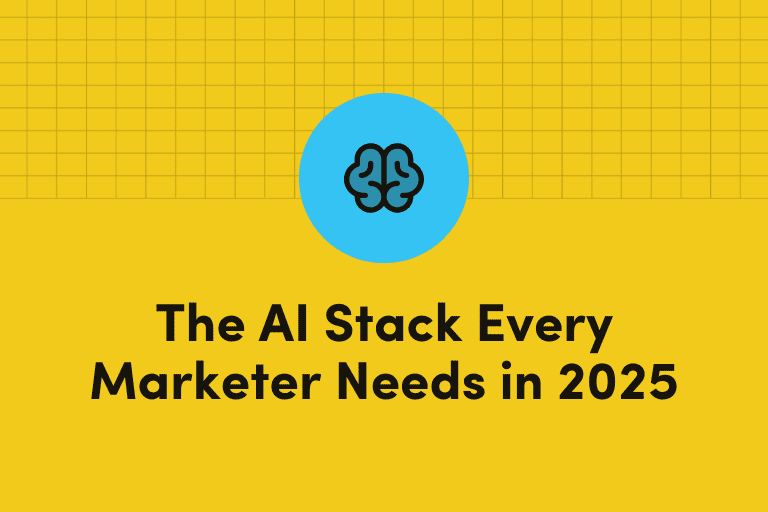It’s 2025, and AI has fundamentally changed what marketing can do. Yet many teams are still relying on legacy tools built for a world that no longer exists—static calendars, siloed workflows, and one-size-fits-all messaging. In today’s landscape, that’s not just inefficient—it’s a competitive risk. Modern marketers need modern tools: intelligent, adaptive, and designed for real-time engagement at scale.
But with AI tools launching every week, the landscape can feel overwhelming. Which ones actually deliver impact—and which are just noise? That’s why we built this guide: to cut through the clutter and spotlight the platforms driving real results. From research to execution, these are the AI tools top marketers actually use to boost efficiency, drive growth, and stay ahead.
What is AI Used for in Marketing?
AI in marketing refers to the use of artificial intelligence to automate, optimize, and personalize customer interactions at scale. It’s used to analyze large datasets, generate content, predict user behavior, and improve campaign performance across every stage of the customer journey.
Common applications include:
- Audience segmentation: Grouping users based on real-time behavior and preferences
- Content creation: Writing, designing, and personalizing messages automatically
- Performance optimization: Testing, refining, and delivering messages at the right time and channel.
- Predictive analytics: Anticipating customer actions to improve targeting and conversions
By integrating AI tools into your stack, marketing teams can save time, uncover deeper insights, and drive better outcomes without manual guesswork. The key is choosing the right tools for the job—which depends on your goals, resources, and use cases. In the sections below, we’ll break down the most important categories of AI marketing tools and how they can support your strategy.
Categories of AI Tools for Marketers
- The Best AI Tools for Assistance & Research
- The Best AI Tools for Content Creation & Editing
- The Best AI Tools for Productivity & Collaboration
- The Best AI Tools for Insights & Intelligence
- The Best AI Tools for Customer Engagement & Personalization
- The Best AI Tools for Optimization & Workflow Orchestration
- The Best Overall AI Marketing Tool
Best AI Assistants & Research Tools
ChatGPT
Best Used For: Content creation, simple coding, strategy prompts, fast ideation
Overview: ChatGPT is the leading large language model (LLM) and a handy marketing tool. It can help you strategize, write first drafts of marketing materials, and analyze data to make more informed decisions. It’s like a 24/7 assistant who can do anything — as long as you stay within your plan’s request limits.
AI Features Snapshot:
- Generative ideation: Find the right approach sooner with generative ideation. ChatGPT can help with every step of the process, from content drafting to performance analysis.
- Code assistance: ChatGPT supports HTML, SQL, and other code snippets to help you optimize landing pages, emails, and other key touchpoints.
- Summaries and analyses: You can share large documents and complex web pages with ChatGPT to have them summarized in seconds.
Claude
Best Used For: Coding, long-form writing, infusing your brand’s voice into new content
Overview: Claude is an LLM by Anthropic that excels at coding and nuanced writing. It offers better memory retention during extended conversations than alternative tools, along with a Styles feature that helps maintain a consistent tone across every piece of content you create.
AI Features Snapshot:
- Long-context handling: Claude thrives at processing and summarizing large documents. It can help you use these resources in your strategies with less manual effort.
- Coding capabilities: Claude’s coding tech supports debugging, algorithm optimization, and code analysis.
- Human-like writing: Claude’s Styles feature lets users tailor AI responses to match their preferred communication style. Importantly for marketers, this makes it easy to generate content in your brand’s unique voice every time you give it a prompt.
Gemini
Best Used For: Coding, multi-modal research, marketing jobs within the Google Workspace ecosystem
Overview: Gemini is an LLM that offers seamless integration with Google Workspace. It also supports multi-modal queries and has advanced coding capabilities. Like ChatGPT and Claude, you can use it for a variety of marketing tasks, including content creation, target audience analysis, and competitor research.
AI Features Snapshot:
- Native Google Workspace integration: Use the LLM natively within Docs, Sheets, and Gmail, delivering AI marketing support wherever you need it.
- Multi-modal input: Gemini understands text, images, and code, so you can rely on it to help your team tackle almost any type of content.
- Live web access: The LLM pulls real-time data from the internet, ensuring every piece of information you rely on is vetted and based on the latest context.
NotebookLM
Best Used For: Research projects within the Google Suite
Overview: NotebookLM is a Google-backed AI workspace that acts as your virtual research assistant. Just provide the files, and the platform will summarize them, highlight key insights, and help you answer important questions.
AI Features Snapshot:
- Custom source training: NotebookLM learns from the materials you upload. This customizes the research tool over time, making it a better and better fit for your unique needs.
- Contextual Q&A: Ask questions about files you upload, and NotebookLM will answer them in context. It provides citations from your resources, so you can quickly find the passages you need in lengthy documents.
- Audio overviews: NotebookLM makes it easier to extract insights from large datasets and reports with genAI audio overview capabilities—allowing you to absorb information hands-free through spoken recaps of your source material.
Perplexity
Best Used For: AI-powered research, content sourcing, fact-finding
Overview: Perplexity is an AI search engine and LLM that offers many of the same services as the other marketing AI tools in this section. It stands out for its cited answers, helpful organizational features, and access to real-time online resources.
AI Features Snapshot:
- Cited answers: Perplexity makes it easier to validate responses by including sources with answers.
- Query collections: You can group similar requests together to keep every distinct project organized in its own place.
- Real-time web search: Like Gemini, Perplexity searches the internet in real time, delivering more accurate content that reflects the latest understandings.
Best AI Content Creation & Editing Tools
Canva
Best Used For: AI-assisted design and copywriting
Overview: Canva streamlines content creation with its drag-and-drop tools for creating marketing visuals. You can use it to quickly spin up an engaging social post, presentation, or banner ad, while also getting help with image editing and copywriting.
AI Features Snapshot:
- Magic write: Canva can auto-generate your headlines, body copy, and captions based on the designs you create.
- Magic design: Create custom, branded designs in seconds with nothing more than a text prompt.
- Magic edit: Make your visuals shine with automated AI editing. Canva supports background object removal, object replacement, and auto-enhancements.
Compose.ly
Best Used For: Human-in-the-loop AI writing for search engine optimization (SEO) and brand voice
Overview: Compose.ly combines AI-generated outlines or drafts with expert human review to produce high-quality, on-brand content. This hybrid approach empowers marketers to scale content creation without sacrificing quality
AI Features Snapshot:
- Custom GPT & prompt engineering: Compose.ly’s in‑house AI specialists train a tailored model specific to your brand voice—ensuring privacy and consistency in output.
- SEO intelligence: Recommendations are SEO-centered, informed by keyword research and optimized through proprietary best practices.
- Human QA layer: Expert editors fact-check, refine tone, and ensure content meets E‑E‑A‑T criteria—elevating outputs beyond standard LLM quality.
Descript
Best Used For: Audio and video editing with AI transcriptions
Overview: Use Descript to edit audio and video with just a few text prompts. The tool makes it easier to consistently create podcasts, video clips, and social media assets.
AI Features Snapshot:
- Overdub voice cloning: Automatically correct mistakes with AI voice matching technology. You can also add new lines to content that already exists.
- Auto transcription: Instantly convert your words into an editable transcript, giving your target audience a new way to consume your content.
- Filler word removal: With a single click, delete filler words like “uh” and “um” that distract from your message.
Grammarly
Best Used For: Grammar checking, tone improvement, and overall writing clarity
Overview: Grammarly uses AI to check your content for errors as you write. It can help you identify grammatical mistakes while also optimizing your tone to align with the voice you want your brand to project.
AI Features Snapshot:
- Tone detection: Flags the emotion that your tone projects and suggests tweaks to help you appeal to different audience types.
- Rewrite suggestion: Offers full-sentence rewrites to help with clarity and brevity.
- Goal-based edits: Can help you edit content based on a specific goal, such as trying to close a customer from a particular audience segment.
Iterable
Best Used For: Ideating and writing tailored marketing messages for different audiences and channels.
Overview: Iterable’s Studio makes content creation a breeze. It can help your marketing team draft, refine, and personalize messages more efficiently with automated tips for every use case.
AI Features Snapshot:
- Journey Assist: With AI-powered prompts, Iterable generates sophisticated journeys in record time based on industry standard best practices.
- Copy Assist: Enhances and expedites the process of writing copy for your campaigns making it easy to tailor content in real time with goal-based phrasing options.
SurferSEO
Best Used For: AI-powered content optimization for search rankings
Overview: SurferSEO uses AI to analyze search engine results pages and provide data-driven guidance. The platform can help you find the optimal structure and keyword breakdown for a piece of content, enabling it to capture more traffic with less guesswork.
AI Features Snapshot:
- Content score: Every piece of content receives an SEO score benchmarked against over 500 ranking factors to provide data-driven insights for keyword and content optimization.
- AI humanizer: Transforms AI-generated content into natural, human-like text, making it ideal for anyone looking to improve the authenticity of their writing.
- AI detector: Helps users distinguish between human-written and AI-generated content.
- AI outline creator: Creates structured outlines for any content type with subheadings and talking points for your chosen topic.
Vidoso
Best Used For: Simplifying content creation and video repurposing
Overview: Vidoso leverages generative AI to transform long-form videos into short clips and other formats while maintaining branding consistency. It’s a helpful tool for marketing teams that want to extend the impact of their video content through scalable, automated workflows.
AI Features Snapshot:
- AskClip: Automatically generates short, engaging clips from longer videos, identifying key moments and turning them into social media content.
- AskContent: Multi-modal genAI transforms a single video or asset into various formats like blog posts, social media posts, case studies, and nurture emails.
- AI studio: Adapts video for your preferred use case by auto-selecting the best framing and crop mode (static, dynamic, adaptive).
Best AI Productivity & Collaboration Tools
Airtable
Best Used For: Smart database collaboration and no-code custom apps
Overview: Airtable combines spreadsheets with AI to help marketing teams track assets, campaigns, and data workflows in a flexible, visual way
AI Features Snapshot:
- Omni: Build powerful apps, intuitive interfaces, and effortless automations through conversational interface
- Field agents: Research, analyze, and create content within every workflow, enriched with real-time company data.
- AI matching: AI can suggest relevant matches based on the data in linked tables and existing examples, helping users connect information more efficiently.
Asana
Best Used For: Project management and team collaboration
Overview: Asana is a project management platform that helps teams stay aligned and efficient. It features automated workflows, goal tracking, and AI-powered insights, among other project management features.
AI Features Snapshot:
- AI studio: Create automated end-to-end workflows (from requests to reporting) for campaigns, launches, strategic roadmaps, and any other project type without any coding.
- Smart assists: Surface progress reports, summaries, and next steps with natural language queries so you can share insights and make decisions faster.
- Smart goals: Standardize cross-organization goals, using AI to predict bottlenecks and align dependencies seamlessly.
ClickUp
Best Used For: Knowledge and task management and workflow automation
Overview: ClickUp helps marketing teams manage their projects with AI assistance. The platform can help to coordinate content calendars, protect campaign timelines, and keep your group on the same page as its goals evolve.
AI Features Snapshot:
- Brain assistant: Create a project brief reminder, chat message, image, voice clip, and more using natural language prompts.
- Brain MAX: AI-powered desktop companion that searches every app, including Google Drive, GitHub, Salesforce, Figma, Dropbox, Confluence, Box, and more
- Autopilot agents: Adapt to changes in your Workspace to autonomously manage tasks, projects, team updates, and more––available as pre-built or custom no-code builds.
Motion
Best Used For: Managing tasks, projects, and calendars
Overview: Motion leverages AI to help you create a more optimized team. You can use it to automatically plan tasks, adjust as deadlines shift, and reschedule conflicts automatically.
AI Features Snapshot:
- AI calendar: Instantly recalculates your schedule when plans change and spots project bottlenecks early, so nothing catches you off guard.
- AI workflows builder: Turns unstructured processes and scattered information into fully customized, auto-assigned, and auto-scheduled projects.
- AI document assistant: Automatically extracts tasks, assigns work, schedules priorities, summarizes content, and drafts documents
Otter.ai
Best Used For: Transcribing and summarizing meetings
Overview: Otter.ai captures meetings and calls in real time, then uses AI to summarize them. This creates searchable transcriptions with summaries and action items you can use to keep your entire team on the same page.
AI Features Snapshot:
- AI chatbot: Ask questions and collaborate in real-time with the transcription, or even have AI generate text like email drafts based on the transcript.
- Speaker identification: Identifies and labels different speakers in a conversation, making it easier to understand who said what during a meeting.
- Automatic summaries: Automatically generate meeting highlights and action items, so people who didn’t attend can catch up quickly.
Reclaim
Best Used For: Smart task and calendar automation with AI prioritization
Overview: Reclaim syncs with your calendar to dynamically optimize your schedule as priorities change. It can help you accomplish more with your working hours, avoid burnout, and adapt your schedule with less work.
AI Features Snapshot:
- Smart meetings: Automatically schedule and manage your recurring meetings – with one-click rescheduling when conflicts come up.
- Focus time: Adapts your schedule so you stay on track with your weekly focus time goals instead of being overrun with meetings.
- Auto-prioritization: Helps you prioritize tasks dynamically as new work comes in.
Superhuman
Best Used For: AI-powered email management
Overview: Superhuman can speed up your email workflow with AI-driven prioritization, smart replies, and context-based suggestions. It can help you keep up with more clients and spend less time digging through your inbox to find the right threads.
AI Features Snapshot:
- Auto draft: Drafts email replies based on context from previous conversations, matching your writing style and tone.
- Auto summary: Condenses long emails threads into short summaries, helping you understand key takeaways quickly.
- Advanced search: Searches your inbox for specific information like flights, meetings, or attachments using natural language prompts.
Best AI Insights & Intelligence Tools
Amplitude
Best Used For: Understanding user behavior within your product
Overview: Amplitude helps teams track how product interactions impact conversion, retention, and revenue. It identifies friction points, segments users by behavioral traits, and tests the impact of changes across the user experience.
AI Features Snapshot:
- Conversion agent: Monitors website performance to detect drops before they affect business outcomes, and uncover exactly where and why users are leaving the funnel.
- Onboarding agent: Evaluates how new users interact with your product UX and creates content to assist users through obstacles in real time.
- Feature adoption agent: Breaks down how different user groups engage with your latest product features and recommends targeted next steps to drive higher adoption.
Gong
Best Used For: Analyzing sales and customer calls for AI-driven insights
Overview: Gong automatically summarizes calls and generates reports that can benefit your business. Marketers use these AI-powered insights to understand customer pain points, track message resonance, and optimize prospecting.
AI Features Snapshot:
- AI call reviewer: Evaluates rep call performance to help managers quickly surface coaching feedback and uplevel teams.
- AI deal monitor: Monitors and notifies you of hidden deal risks so you can take action to improve pipeline health.
- AI ask anything: Instantly answers questions on any account, deal, or contact so you can make better decisions.
Hotjar
Best Used For: Understanding website user behavior and interactions
Overview: Hotjar combines heatmaps, session records, and surveys with the power of AI. It can help you find user behavior patterns and generate insights to improve your website and content engagement.
AI Features Snapshot:
- AI surveys: Generates surveys in seconds based on your defined research goals.
- Response analysis: Summarizes open-ended responses into key sentiments, trends, and themes.
- Actionable insights: Provides actionable recommendations based on the analysis of survey responses.
Iterable
Best Used For: AI-powered engagement scoring and predictive audience insights
Overview: Iterable’s AI agent, Nova, helps make your data not just accessible, but actionable. It helps marketing teams by identifying high-value audiences, anticipating conversion or churn, and suggesting optimal journey paths.
AI Features Snapshot:
- Brand Affinity: Automatically scores users based on their historical engagement patterns with your brand so you can optimize journeys with user-level intelligence.
- Predictive Goals: Forecasts which users are most likely to convert, churn, or reach defined milestones and desired outcomes.
- Reporting Insights: Explainable AI analyzes trends at both the individual and aggregate level and understands the “why” behind each sentiment.
Mixpanel
Best Used For: Analyzing individual user journeys that drive product success
Overview: Spark AI is a conversational assistant made by Mixpanel that helps teams benefit from data. It offers natural language queries, which can help your team pinpoint and learn from behavioral insights with less work.
AI Features Snapshot:
- Custom query generation: Ask questions about user behavior in natural language to make actionable answers accessible to everyone.
- Cohort analysis: Identify valuable user segments and generate cohort recommendations based on product engagement patterns, retention rates, and revenue metrics.
- Automated reporting: Continuously monitor patterns and proactively surface trend analysis and recommendations when data deviated from expectations
Twilio Segment
Best Used For: Unifying and preparing data for AI-powered personalization
Overview: Twilio Segment is a customer data platform (CDP) that collects, cleans, and syncs customer data from various sources into a single, consistent profile ready for AI activation. It empowers marketers to engage customers intelligently without heavy reliance on data teams.
AI Features Snapshot:
- Auto-instrumentation: Automatically collect customer data, eliminating the need for manual code instrumentation and enabling faster analysis
- Generative audiences: Create audience segments using natural language to describe your desired audience based on events performed, profile traits, and more.
Best AI Customer Engagement & Personalization Tools
Digioh
Best Used For: Creating personalized lead forms, quizzes, and pop-ups
Overview: With Digioh, you can leverage AI to create intelligent lead capture tools in minutes. The platform optimizes conversion rates by dynamically adjusting forms based on what it knows about the user engaging with it.
AI Features Snapshot:
- Dynamic forms: Automatically adjusts content and other form fields based on users’ behaviors and attributes.
- AI quizzes: Creates quizzes that feel custom to each individual customer’s journey, combining simple question flows with powerful algorithmic analysis.
- Website accessibility widget: Enhances website accessibility with features like a screen reader, languages, etc., helping businesses comply with regulations and reach wider audiences.
Hootsuite
Best Used For: Social listening and engagement powered by AI insights
Overview: Hootsuite’s AI tools help marketers monitor sentiment across social platforms, draft content, and discover what messages are resonating.
AI Features Snapshot:
- AI-powered social listening: Analyzes millions of online conversations and condenses them into clear, insightful summaries in an easy-to-read format.
- Inbox automations: Set up inbox automations like auto-responses and auto-assignments to slash your team’s response times in half.
- AI-powered hashtag generator: Automatically creates relevant hashtags based on your post’s caption and image.
Iterable
Best Used For: Personalized, real-time cross-channel customer engagement
Overview: Iterable enables marketers to deliver truly individualized experiences at scale. Powered by real-time behavioral data and embedded AI, Iterable personalizes every message and moment—automatically adapting content, channel, and cadence to fit each user’s journey.
AI Features Snapshot:
- Catalog: Powers personalized product or content recommendations from your brand based on individual user data and preferences.
- Snippets: Dynamically swaps in personalized blocks of content, offers, or creative elements for each customer at send time.
- Smart segmentation: Builds dynamic audiences using real-time behavioral and predictive signals—no manual queries required.
Movable Ink
Best Used For: Personalizing dynamic creative content at the moment of interaction
Overview: Movable Ink helps brands create contextualized emails at scale. The platform uses generative AI to alter visuals and writing based on real-time data and integrates with delivery for fewer bottlenecks.
AI Features Snapshot:
- Vision model: Leverages computer vision and natural language processing (NLP) to detect, classify, and tag various visual and text elements from content.
- Generation model: Leverages GPT to help marketers create and scale subject lines that align with the right motivation, intent, and tone for each individual customer.
- Insights model: Learns from user discovery paths to balance the right mix of promotional and editorial content based on evolving tastes and engagement data.
Twilio
Best Used For: AI chatbots that enhance real-time customer conversations
Overview:
Twilio’s AI capabilities power intelligent chat experiences that help brands improve engagement and support without relying on human intervention for every interaction. The platform is designed to understand user intent and seamlessly route inquiries in real time.
AI Features Snapshot:
- AI assistants: Leverage large language models (LLMs) to handle complex interactions and provide dynamic responses based on customer history and message context.
- Conversational intelligence: Transforms unstructured conversational data into actionable insights that can be used to assess and enhance the performance of your voice AI agent.
- Conversation relay: Create seamless, natural voice interactions and bridge communication between AI agents and human reps by summarizing conversations and surfacing the most relevant context.
Zendesk
Best Used For: Automating customer service workflows and insights
Overview: Zendesk uses artificial intelligence to route tickets, detect customer sentiment, and suggest replies. It helps brands manage customer conversations more effectively, leading to improved outcomes.
AI Features Snapshot:
- Intelligent triage: Uses intent detection, language detection, and sentiment analysis to classify incoming requests and allow teams to power workflows based on these insights.
- Suggested first replies: Suggests a first response for agents in tickets based on existing macros and help center articles, saving time and increasing productivity.
- Ticket summaries: Ticket summaries recap the public comments that have been added to a ticket so far, helping agents get up to speed and respond to customers more quickly.
Best AI Optimization & Workflow Orchestration Tools
Iterable
Best Used For: AI-powered optimization of cross-channel workflows and customer journeys
Overview:
Powered by the built-in AI agent, Nova, Iterable orchestrates real-time decisions across channels—automating when, where, and how to engage each customer based on behavior, preferences, and predictive insights. This allows marketers to scale personalization without manual effort.
AI Features Snapshot:
- Send Time Optimization: Determines the ideal moment to reach each user, increasing open rates and response likelihood across email, SMS, and push.
- Next Best Action: Identifies the highest-impact next step for each individual based on behavioral patterns and past campaign performance.
- Journey Assist: Streamlines journey building with AI-generated workflows, recommending logic and steps to guide users toward conversion with fewer dead ends.
Zapier
Best Used For: Workflow automation and AI-based app integration
Overview: Zapier leverages AI to help marketers build smarter workflows that can adapt in real time. It connects thousands of tools and automates repetitive processes, saving hours of manual effort.
AI Features Snapshot:
- Model context protocol: Translates between AI tools and apps to quickly and securely connect your AI platform of choice to more than 30,000 actions.
- Canvas: Map out entire workflows with AI-powered diagrams, so you can identify bottlenecks and keep everyone aligned on how your team operates.
- AI-powered zaps: Build automations using natural language instead of manually configuring a complex tool.
Best Overall AI Marketing Tool: Iterable
We might be biased—but when you’ve built the platform redefining AI-powered marketing, it’s hard not to make the case! Unlike point solutions that solve for one step in the journey, Iterable powers the entire customer experience. It replaces rigid campaign calendars with adaptive, moment-based engagement, using Iterable Nova—our native AI agent—to learn from every interaction, predict what comes next, and adapt messaging in real time so your brand stays relevant, never repetitive.
From copy to cadence to customer journey—here’s what powers Iterable’s edge:
- Brand Affinity: Score each customer’s relationship to your brand to guide targeting, messaging, and timing.
- Copy Assist: Write better content, faster, with goal-based AI suggestions for emails, templates, and SMS.
- Journey Assist: Use natural language to design smarter customer journeys, built by AI in seconds.
- Send Time Optimization: Deliver each message at the moment your customer is most likely to act.
- Frequency Optimization: Personalize message cadence so no one gets overwhelmed—and no opportunity is missed.
- Channel Optimization: Reach users on the channel they’re most likely to engage with—automatically.
- Next Best Action: Automatically determine the ideal next step for each individual, based on their behavior.
- Predictive Goals: Forecast future actions—like conversions or churn—and align your strategy accordingly.
Iterable isn’t just part of your tech stack—it’s the AI engine that drives it. If your team is ready to move beyond campaign cycles and into continuous, personalized engagement, there’s no better foundation than Iterable.
AI Marketing FAQs
1. What should marketers consider before investing in AI tools?
Before adopting any AI solution, evaluate whether your strategy, team, and data infrastructure are ready to support it. AI doesn’t deliver value in a vacuum—it amplifies what already works. That’s why successful marketing teams align around clear objectives, clean and accessible data, and the right operational structure.
“Future-ready stacks are flexible, well-integrated, and built on strong data foundations with embedded AI, open architecture, and clear roadmaps. Success also hinges on scalability, governance, and user adoption.”
—Adam Chandley, Head of Technology Strategy at Merkle
2. How do I choose the right AI tool for my needs?
AI tools fall into categories like content generation, analytics, personalization, and orchestration. Start with your goals: Do you need to scale creative output? Improve segmentation? Optimize engagement timing? Once defined, prioritize platforms with embedded AI and native integration capabilities that align to your needs.
3. What is agentic AI?
Unlike generative AI, which creates content (think writing emails, designing assets, or summarizing data), agentic AI takes action. It’s autonomous, goal-oriented, and capable of executing tasks without human prompts. That includes things like re-engaging users, optimizing message delivery, or resolving support tickets in real time.
Agentic AI isn’t a future capability—it’s the standard for brands that want to scale personalization with the resources they have.
“Predictive analytics and generative AI are delivering measurable value in customer insights and scalable content creation, while agentic AI is freeing up human resources by handling complex tasks.”
—Adam Chandley, Head of Technology Strategy at Merkle
4. What is built-in vs. bolted on AI, and why does it matter?
Bolt-on AI tools are often retrofitted, requiring extra setup and rarely working as fluidly across the stack. Built-in AI, on the other hand, is seamlessly embedded in a platform’s architecture—it’s not an afterthought, integration, or plug-in.
“Built-in AI is considered table stakes in today’s requirements… Few companies have their own models ready for production, so a built-in model allows organizations to leverage AI in a way they can activate immediately.”
—Julien De Visscher, Managing Director at Human37
Built-in AI means intelligence is available at every touchpoint: while building journeys, writing copy, or triggering the next action. It’s more responsive, more consistent, and easier to activate across every step of the customer journey.
“I believe that built-in AI is a strategic advantage in a martech platform… We’re transitioning to a built-in AI martech world, but many of the current offerings are bolt-on AI, packaged in various ways by marketing teams.”
—Jon Goodman, President at Range Digital
Final Take: Make Your Stack Work Smarter, Not Harder
AI has redefined what’s possible in marketing—but success isn’t just about tools. It’s about how you activate them. With the right strategy and smarter workflows, teams can move faster, engage deeper, and outpace the competition.
|
Our Checklist for Unlocking the Power of AI is your starting line. Use it to identify high-impact moments, streamline manual tasks, and start building the AI-powered marketing engine your customers—and your team—deserve. Or, if you’re ready to see Iterable’s AI superpowers in action, check out our 5-minute demo. |

































